
Reproduction
Mating:
Jackson Chameleons reach sexual maturity at 5 to 7 months of
age. However, females are more likely to face reproductive
related issues if mating before the age of 12 months. Mating
periods for Jackson Chameleons are triggered by the local
weather conditions. Several days of high temperatures and long
hours of daylight mark when the mating period begins (McKeown
1997). Jackson Chameleons are considered
to be invert chameleons. When out of mating season Jackson
Chameleons will often avoid each other regardless of sex and if provoked will hiss and warn the opposing chameleon to
leave. When in mating season, Jackson chameleons become more
active and will seek for mates of the opposite sex, but finding
the perfect mate is determined by several different factors
(Holland et al. 2010).
Like in most animals, the female chooses who she wishes to mate
with. Female Jackson Chameleons base their mating decisions off
several different features and abilities, which the male
displays through mating rituals.
When a male Jackson Chameleon encounters a female the mating
ritual commences. The male attempts to impress the female by
swaying back and fourth and bobbing his head in different
 patterns, almost as if he were dancing. The male will also
extend his neck as far out as possible and open his mouth wide
to create the illusion that he is bigger. By extending
the neck and opening the mouth, the male, exposes and flexes the
muscles, which are responsible for catching pray and gaining
nutrients. This shows the female whether or not if its offspring
will be more genetically probable to have advantages in the area
of hunting and nutrient consumption, which would increase the
likelihood of survival (Holland et al. 2010). The male, well still “Dancing”, lifts his
front two legs up to show how well it can balance and also how
strong he is. The most remarkable and mesmerizing part of the
ritual is the color display put on by the male. He will rapidly
change colors in attempts to create the most unique and
vibrant color displays to help catch the female’s attention.
This shows the female how capable the males camouflage ability
is and also whether or not the offspring will have better
chances of reproducing and attracting mates of their own.(Holland
et al. 2010)
patterns, almost as if he were dancing. The male will also
extend his neck as far out as possible and open his mouth wide
to create the illusion that he is bigger. By extending
the neck and opening the mouth, the male, exposes and flexes the
muscles, which are responsible for catching pray and gaining
nutrients. This shows the female whether or not if its offspring
will be more genetically probable to have advantages in the area
of hunting and nutrient consumption, which would increase the
likelihood of survival (Holland et al. 2010). The male, well still “Dancing”, lifts his
front two legs up to show how well it can balance and also how
strong he is. The most remarkable and mesmerizing part of the
ritual is the color display put on by the male. He will rapidly
change colors in attempts to create the most unique and
vibrant color displays to help catch the female’s attention.
This shows the female how capable the males camouflage ability
is and also whether or not the offspring will have better
chances of reproducing and attracting mates of their own.(Holland
et al. 2010)
 In some cases two males will try to entice the female at the
same time. If the female refuses to pick one of them the two
males will spar with each other. The males charge at each other
and once in range use their horns to joust with the other male.
The winner is determined by whichever male chooses to back down
first, is unable to compete anymore, or is knocked off the
branch the female is occupying. Once a victor is determined the
conquering male will attempt to entice the female once again.
(McKeown 1997)
In some cases two males will try to entice the female at the
same time. If the female refuses to pick one of them the two
males will spar with each other. The males charge at each other
and once in range use their horns to joust with the other male.
The winner is determined by whichever male chooses to back down
first, is unable to compete anymore, or is knocked off the
branch the female is occupying. Once a victor is determined the
conquering male will attempt to entice the female once again.
(McKeown 1997)
If the female chooses not to mate with that specific male she
will warn the male by preforming a “dance” of her own. The
female will rock violently back and forth and bobble her head in
a aggressive manor showing her lack of interest well her tail
coils inward to deter any attempt at mating. She will also
change her skin color to a darker color with a molted pattern
being displayed. On the other hand, if the female accepts the
male as a mate she will lighten her skin color, curl her tail in
an inviting manor to the male, to assist with the actual mating,
and remain submissive when approached by the male. (O'Meara
2001)
Once the male gains acceptance from the female chameleon the
male will use his mouth to grip the female’s neck to assist in
the mounting process. Once properly mounted, the male inserts
one of his two hemipenes into the female’s cloacal opening.
Copulation between the two can take anywhere from ten to thirty
minutes. Once done the male leaves the female and both the male
and female go out to search for another potential mate. The
female will continue on mating for
eleven days,
but never with the same male twice on the same day (Benirschke
2006).
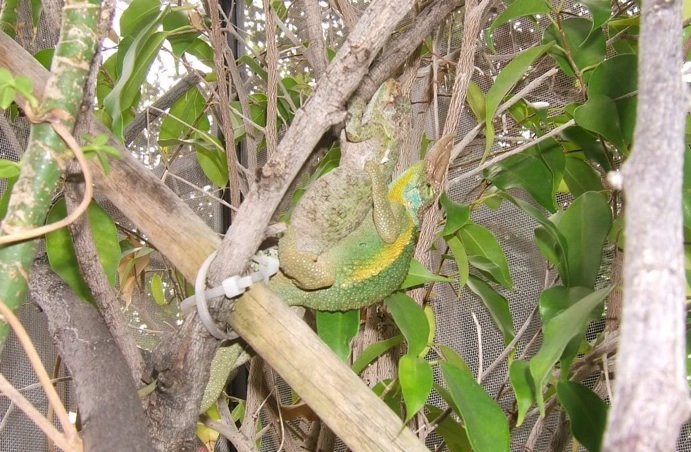
Gestation and Birth:
Gestation commonly last around seven to ten months after
copulation. In this period, the female’s body
appearance becomes lumpy and causes her to become clumsy.
The
appearance change is caused by the development of anywhere
from 10-43 separate embryos developing
within the female, although more and less then this range has
been recorded in specific situations. The female becomes increasingly more stressed
through gestation due to the difficulty of preforming everyday
activates and also the added stresses of finding additional
needed nutrients for herself and her young (Benirschke 2006). Jackson
Chameleons
are ovoviviparous. This means that the offspring completely
develop inside the mother and once full development is reached
the female chameleon gives live
birth. When it comes time to
born
the offspring the female will walk across branches while
releasing the fully developed chameleon, still in its embryonic sac
during birth, one by one onto the branch below it, or let it fall to
whatever lies below. The female is able to release each infant
chameleon, still in a protective membrane, because there is no true
umbilical cord attaching the mother to her young. The embryonic sac
is covered in embryonic fluids, which make the sac likely to stick
to branches and leaves below. By dropping the offspring from great
heights the embryonic sac, which is now more like a thin membrane
covering, is weakened allowing offspring to more easily escape the
membrane(Kundinger 2001). Once born the infant Jackson Chameleons
stretch and move to break their thin membrane surrounding them. Once
the membrane is broken the infant chameleon is able to function
completely independently from its mother (O’Meara 2001).
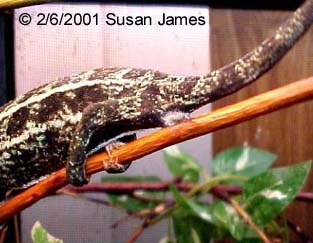 |
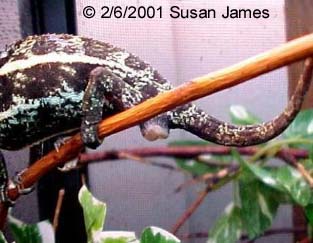 |
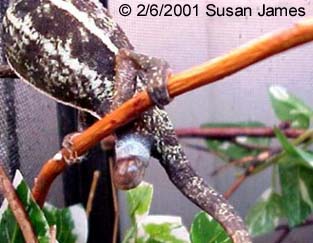 |
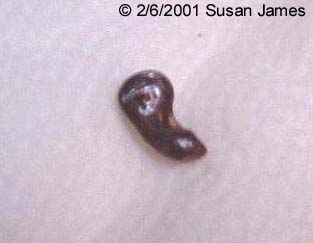 |
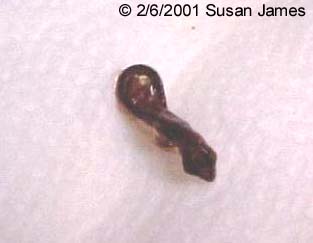 |
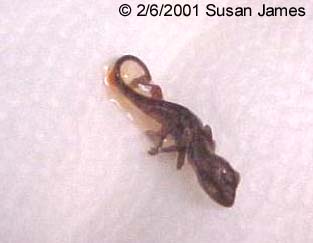 |
At birth the infant Jackson Chameleon measures in at around 52-55 mm in length and weighing .5 grams on average. In the first 24 hours after birth the infant chameleons are ready and able to start the hunt for food. At only two months of age the development of horns on their crest begins. When the age of 5 months is reached the chameleons will grow to 8-10cm in length and will only be a few short months away from reaching sexual maturity allowing them to mate and continue the circle of life (O’Meara 2001).